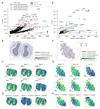SpatialDE: identification of spatially variable genes
- PMID: 29553579
- PMCID: PMC6350895
- DOI: 10.1038/nmeth.4636
SpatialDE: identification of spatially variable genes
Abstract
Technological advances have made it possible to measure spatially resolved gene expression at high throughput. However, methods to analyze these data are not established. Here we describe SpatialDE, a statistical test to identify genes with spatial patterns of expression variation from multiplexed imaging or spatial RNA-sequencing data. SpatialDE also implements 'automatic expression histology', a spatial gene-clustering approach that enables expression-based tissue histology.
Conflict of interest statement
The authors declare no financial conflicts of interest.
Figures


Comment in
-
Transcriptomics: Finding structure in gene expression.Nat Rev Genet. 2018 Apr 13;19(5):249. doi: 10.1038/nrg.2018.19. Nat Rev Genet. 2018. PMID: 29651100 No abstract available.
References
-
- Achim K, et al. High-throughput spatial mapping of single-cell RNA-seq data to tissue of origin. Nat Biotechnol. 2015;33:503–509. - PubMed
-
- Junker JP, et al. Genome-wide RNA Tomography in the zebrafish embryo. Cell. 2014;159:662–675. - PubMed
-
- Chen J, et al. Spatial transcriptomic analysis of cryosectioned tissue samples with Geo-seq. Nat Protoc. 2017;12:566–580. - PubMed
Publication types
MeSH terms
Grants and funding
LinkOut - more resources
Full Text Sources
Other Literature Sources

